Sand Crabs and Surf Fishing: How To Find Them
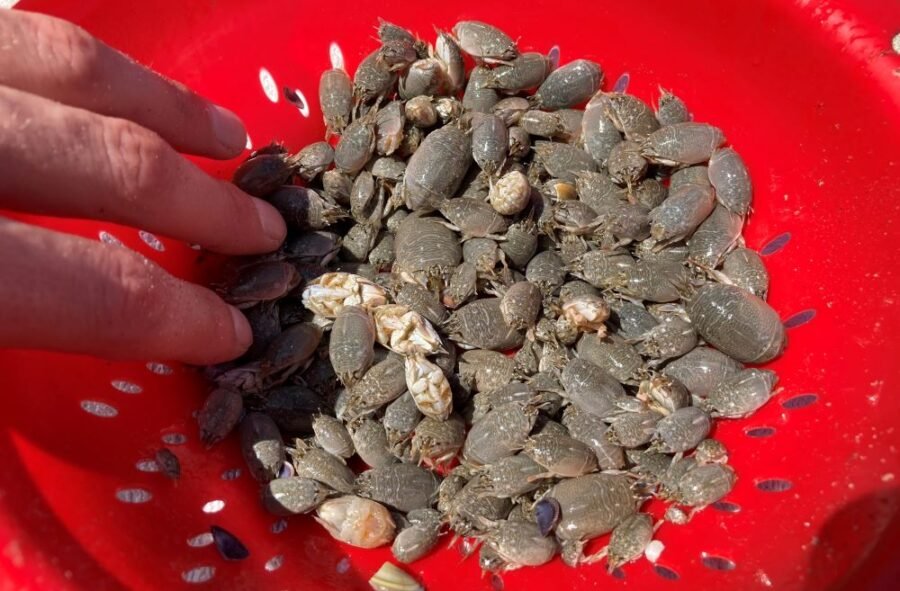
In this article, we’ll be covering the topic of sand crabs and how to use them for surf fishing bait. We’ll go over how to find sand crabs (including some tips on finding them in the spring and fall). We’ll cover what happens to them after summer, what type and size is best for bait, how to hook sand crabs for surf fishing bait, and more!
Commonly referred to as sand fleas and mole crabs, Pacific sand crabs (Emerita Analoga) are the main species of their genus local to Southern California. While they serve as a main food source for many marine animals and birds, they’re a premium bait choice when it comes to surf fishing.
Facts About Sand Crabs:
- Females grow nearly twice as large as males (average-maximum size of 1.5 inches long and 1 inch wide).
- The legal limit via CDFW is 50 crabs in possession per angler.
- Females can be differentiated from males by the orange eggs they carry on their underside.
- Sand crabs essentially live their lives in reverse as they swim and burrow backwards.
- Females can lay batches of up to 45,000 eggs.
- Sand crabs take about half a year to mature to adults.
- What do sand crabs eat? Sand crabs eat plankton that they catch it by using their antennae.
- The typical lifespan of a sand crab is 2 years ( usually ending in autumn).
- Do sand crabs breathe air? For this question, I couldn’t find any info specifically pertaining to them. I did however find info on crabs in general. Crabs have gills, but unlike fish, crabs need only to keep their gills moist to maintain adequate oxygen levels. Some crabs can live their entire lives out of water if the humidity is properly maintained. The closest category to sand crabs I could find was “aquatic crabs” and those are said to be able to live 1 to 2 days out of water.
Info above was found on wikipedia: https://en.wikipedia.org/wiki/Emerita_analoga
How To Find Sand Crabs
Long before I learned about surf fishing, I would spend summer days playing in the water and on the sand. Being one of four brothers, finding and catching bug-like critters was always high on the list of priorities. So, before I ever knew the value of sand crabs in terms of surf fishing, I knew exactly what to look for and how to find them.
I’ve always used a colander to catch sand crabs, but some people just use their hands and others have had good success with nets. I’ll find a bed (group of sand crabs burrowed underneath the sand), scoop the sand into my colander, and sift it out in the water. The result is usually a colander full of crabs, shells and other beach remnants.
What to Look For and How to Find Sand Crabs
Look for the little “v” markings in the sand
It’s true, each individual sand crab will leave a little “v” indentation in the sand. It’s also true that any other particle (that is notably bigger than a grain of sand) that becomes embedded in the sand will form a similar v-shaped marking. You might get mixed up and find a bed of clams, but keep looking and you’ll find what you’re looking for.
Look for their antennae sticking out of the sand
After the water recedes, you’ll see their antennae sticking out of the sand. This is them trying to gather plankton as it gets swept around in the surf. This is also a good tip, but there’s another method that’s much easier.
Look for rough patches of wet sand after the water recedes
I think this is the best way of describing what to look for. They’ll be in beds and you’ll see these beds as the water recedes after a wave dissipates on the shore.
These critters will cause disturbances in the very thin layer of water that passes above them. It’d be easiest to understand what I’m talking about by watching the video above or seeing it in person.
Check out the photo below. There’s a real nice bed of sand crabs in the background on the sand. All that grainy texture in the sand is one big sand crab bed.
If that photo doesn’t quite do it for you, either watch the full video or watch this quick short video below.
Best Size and Soft-Shelled Crabs
Use small sand crabs
Many anglers dig around for the biggest crabs they can find and use those. I like to use small crabs about the size of my pinky or sometimes index finger nail.
Don’t use big sand crabs
In the photo below, the crab with the arrow pointing to it is too big for my likings. If I catch a crab like this, I’m likely going to throw it right back into the sand. Sand crabs of this size are good for big guitarfish if you sling your bait out real far. Sometimes big spotfin and corbina will take on these but it might take all day for that one big fish. Otherwise, you’ll get a lot of nibbles that don’t result in full takes.
Soft shelled sand crabs
The sand crab with the black circle around it is a soft-shelled sand crab. It’s a crab that has just recently molted, therefore, it’s softer than the others in the batch. You can distinguish these guys as they’re usually semi-translucent.
These soft-shelled sand crabs are highly desirable to corbina and croaker and in my experience, you’re nearly twice as likely to get a bite on soft-shelled crabs than on hard-shelled. While that soft-shelled crab in the picture is very close to my ideal size, I like them a tad smaller.
The crab circled in blue is my ideal sand crab size. Don’t get me wrong, some days, that soft-shelled size will work better. But, in my overall experience, putting two crabs the size of the blue-circled one on a size 4 or 2 mosquito hook is the most productive method and size. You’ll catch more fish in general, including more sizable fish. If that smaller crab were soft, it’d be my ideal crab altogether.
Big fish take on small sand crabs
Many anglers will argue, “bigger bait = bigger fish”. While that’s true of some species, it’s not the case with corbina, spotfin croaker, surfperch, and yellowfin croaker. They like that smaller size circled in the above image best.
And again, two or three small sand crabs is much easier for them to take than one big, hard sand crab. My biggest fish have come on sand crabs no larger than the one circled in blue and many have come on 2, 3, or even 4 tiny crabs piled together on a hook.
What Rig for Surf Fishing with Sand Crabs?
Below you’ll see the exact gear and tackle I use. I use a Carolina rig as depicted in this video and that’s that. A nice 2-3 foot leader line of fluorocarbon and you’re good to go. Hook size is a little open-ended as I’ll switch throughout the seasons depending on what’s biting or what bait I’m using. Either way, you can’t go wrong with a size 2 or a size for mosquito hook.
There are some other types of surf fishing rigs, but I won’t go into detail in this article. Refer to the linked article if you’re interested in switching up your rigs.
My Light Tackle Set-Up:
- Rod: Okuma Celilo (8’6″ MA) or the Okuma SST (8’6″ MA)
- Reel: Penn Battle II or III 4000 series
- Mainline: 15-pound monofilament
- For Bait: Carolina Rig:
- Leader Line: 15-pound fluorocarbon
- Swivels: 15-19mm barrel swivels
- Hooks: size #2 or #4 owner mosquito hooks
- Weights: 1-oz egg weight
- Beads: 8mm fishing beads
- For Lures: Lucky Craft FM 110 and Shimano WM 115 SP
- Other best surf fishing rods and best surf fishing reels
How to Hook Sand Crabs
So for this section, I had stumbled across a Facebook post on this topic a while back that peaked my interest. It was a post by an angler named Edward and it was in the Facebook group “West Coast Surf Fishing“. He mentioned a method of hooking the crab not through the shell, but simply through the “digger” and the eggs (if I understood correctly). He stated his hook-up rates increased so it might be worth a shot.
I had originally hooked my sand crabs through the belly and out the shell and it worked well. But, I still had plenty of times where just the eggs were taken or even just the section where eggs might be, was taken. So, I adjusted and for my last 5 years of surf fishing, I’ve hooked them through the top of the shell and out the belly leaving the point of the hook exposed through the section that holds the eggs.

I’d say I get better results with this method, but it seems the missed nibbles here and there are inevitable (depending on the size of the fish).
Can You Find Sand Crabs in the Fall and Winter
Every year, around late-October/November, corbina, croaker and other surf species indigenous to Southern California seem to lessen in numbers on the shoreline. The water temp drops which sets off a long chain reaction eventually pushing the majority of croaker into deeper waters. While going over the entire chain could take forever, the immediate reason for the disappearance of surf species from the shoreline is that sand crabs are no longer plentiful in the winter and even late fall.
Is it still possible to catch sand crabs in the fall and winter? For fall, yes, absolutely! Winter is a little tougher, and for that, continue reading the next couple paragraphs.
We learned above that in autumn of every year, many adult crabs will die off. With that being said, it makes sense that sand crabs start to disappear from our beaches around fall. But, they don’t all die. The stragglers can be found easiest at sunset and an aligning high tide can intensify the showing.
If you read the surf fishing report – Fall Fishing and the sunset bite, it makes sense that the bite would turn on around sunset because more sand crabs take to the shores.
Where Do Sand Crabs Go?
From spring through early fall, sand crabs can be found along the shoreline at both high and low tide in great numbers. During late fall, the water temperature drops and the surf becomes more turbulent. Since they don’t have very keen directional-function via their legs, they follow the flow of the sea. While some manage to burrow themselves deep under the sand, the less-fortunate get swept out to sea in the winter storms.
Additionally, the even less fortunate, will pass away as their lives comes to an end. The result? Fewer sand crabs are readily available as a food source for surf species. So, corbina and croaker are forced to find additional food sources (maybe deeper or elsewhere – bays and estuaries) as they await spring.
This does not mean that corbina and croaker disappear altogether during winter. These surf species can certainly be caught year-round, but from late-fall through early-spring, it can be a difficult task.
Can You Eat Sand Crabs?
Yes, you can eat sand crabs. In fact, it’s quite common in some cultures. Have I ever eaten them? No, I don’t think I ever will. But, I know people who have and it doesn’t take much digging to find out how to prepare sand crabs, how to cook them, and whether or not sand crabs taste good. I’m not the expert there though, so we’ll move on.
What to Use for Bait in the Winter
Although, it’s been said that even in the winter, sand crabs can be found deep below the sand near the bases of pier pillars and similar structure, it’s helpful to have an alternative bait option. If you don’t want to search for sand crabs during the winter or you simply can’t find them, don’t worry. Mussel meat, frozen anchovy, gulp sand worms, and even squid can still produce a bite. My favorite fall and winter time bait is mussel meat and I provide a full breakdown on what type of mussels I use and how to use mussel meat for surf fishing.
Another option, and one that I have committed to during the winter months, is using lures. As the bite dies down, the quantity of catch isn’t anywhere near like it is in the summer, so, going for quality over quantity is an option. I use the winter to catch halibut from the surf with lures.
Subscribe to our newsletter!
References:
- https://www.thoughtco.com/how-do-crabs-breathe-2291887
- https://en.wikipedia.org/wiki/Emerita_analoga
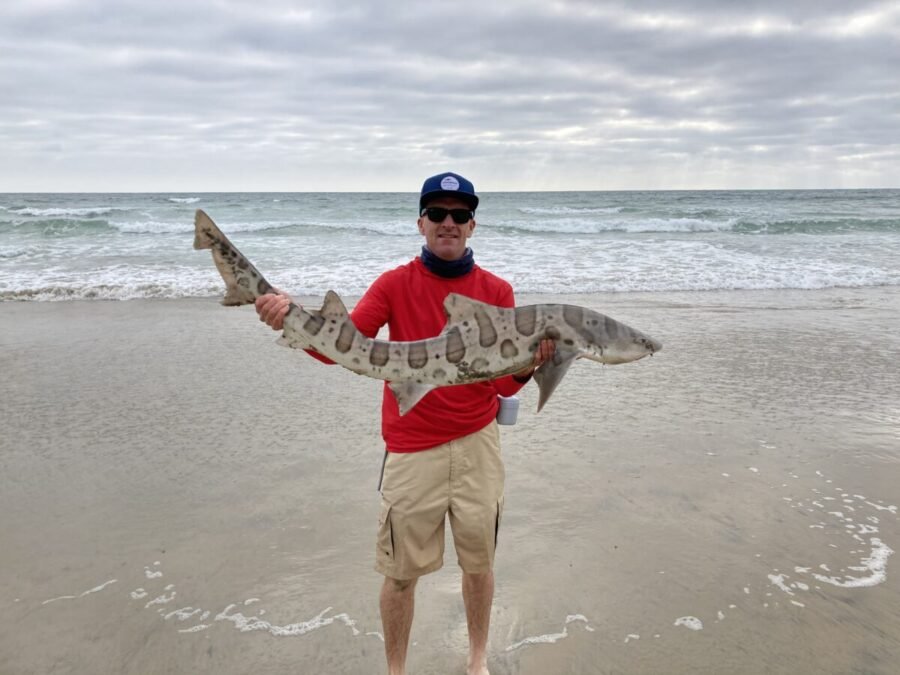
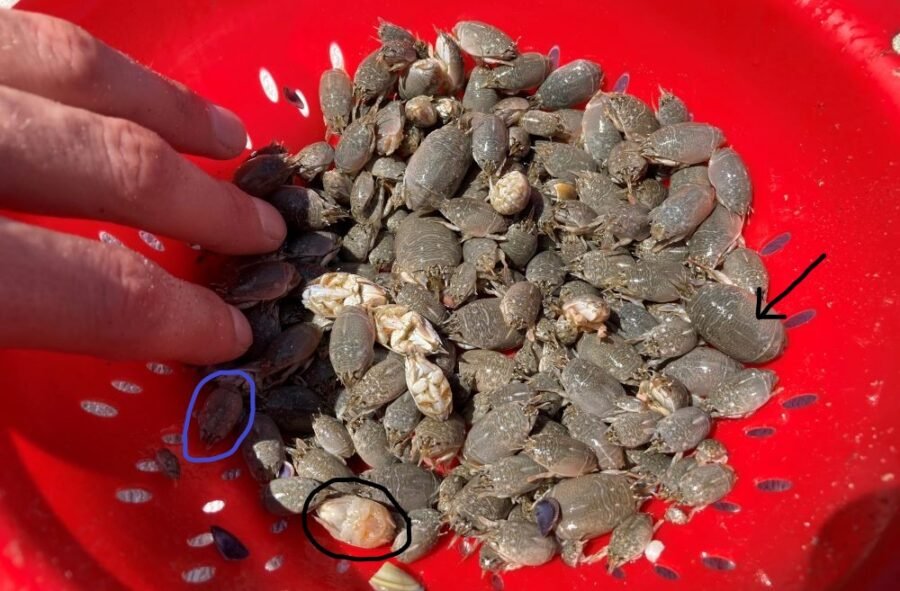
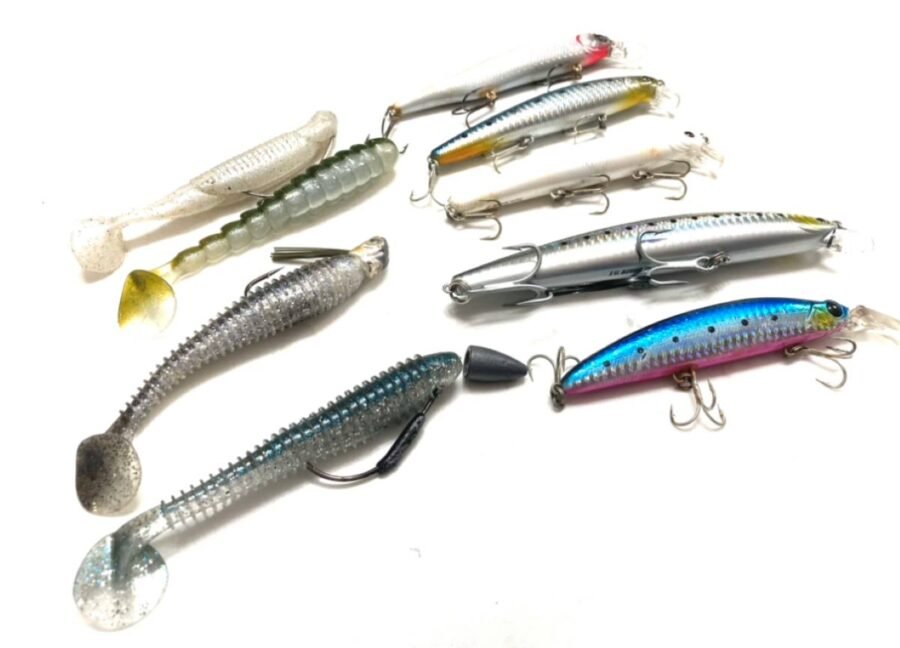

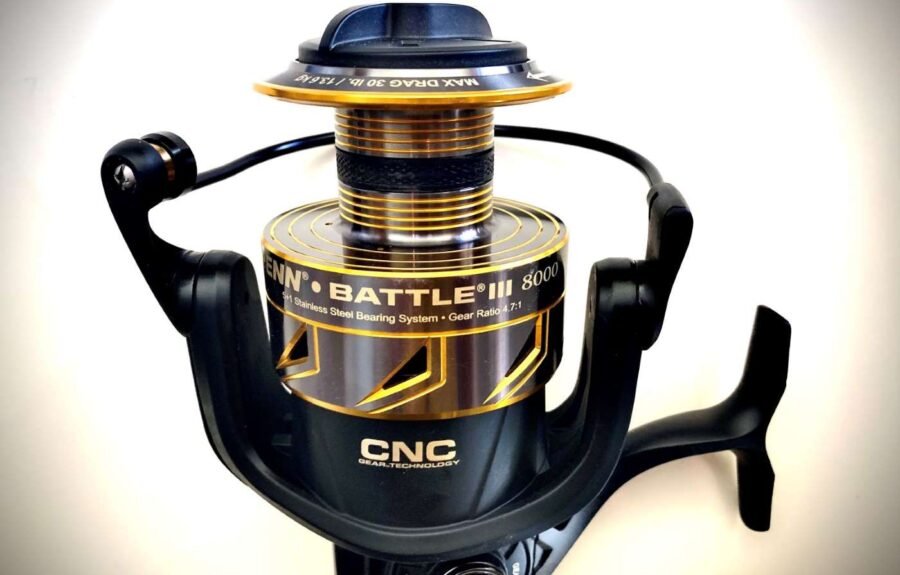
http://surffishingsocalsd.com/best-surf-fishing-spots-in-san-diego/
Here’s a semi-comprehensive list and description of my top rated beaches for surf Fishing in San Diego. If you’d like to get a first hand experience, I’ll be offering guided sessions come late May
Well done my friend
THANKS FOR THE WRIGHT UP ON SANDS CRABS NICK, NOW I KNOW MORE THAN THE NEXT
GUY… GOOD JOB !!!
Awesome! Thanks Richard
Thank for this write up. In my experience it is spot on!
I’ll add, when fishing with sand crabs, I thread a 4mm to 6mm orange bead down the line to rest at the hook’s eye. The bead emulates sand crab roe and definitely helps to get the fish’s attention resulting in more bites.
In June, July and August my fishing buddies and I grin and start a 10 count whenever we cast a perfect soft shell crab with eggs. I’m convinced surf fish see every bait that hits the water and perfect soft shells consistently get bit right away!
Awesome input! I’ve definitely taken part in similar “count downs” after a perfectly placed soft-shelled crab hits the water.
Great articles full of info and tips. My 13yr old son and I just started pier fishing surf fishing is next. Looking forward for info on, New Port,Huntington and Seal Beaches. My son and I would like to sport your T’s while fishing out here. (XXL and XXXL)
Ray Leon
West Covina, CA
Thanks for the support, Ray! Which shirts are you referring to? The new full bend fishing ones: https://fullbendfishing.com
Or the traditional Surf Fishing In So Cal Shirts: http://surffishingsocalsd.com/product/surf-fishing-in-so-cal-t-shirt/
I can go ahead and get a couple XXLs and XXXLs if that’s what you want. Let me know and again thank you!
How much weight where you using? Was it a Carolina rig?
He Curt, when I fish with samd crabs, I use a 1 oz weight with a Carolina rig.
when i was a sprout, bout 8 years old i already had fishing in my blood. my mom wouldn’t buy me shrimp then i discovered mole/sand crabs! and tube worms. i fished alongside the old timers with my Zebco 33 and never left the piers or jettys w/o a string of sheephead, whiting, flounder and occasionally a pompano! ALL for free! I miss those simple days ,but you don’t see kids doing much fishing these days! At least not 8 year olds. I forgot, those crabs even worked frozen!
Awesome story and even better memories! It’s tough to beat the natural food source.
Nick, I’m wondering if you’ve heard about the new CA regulation on harvesting sand crabs. There is a specific list of hand-operated devices (shovels, rakes,etc.) that are acceptable to use when harvesting sand crabs. Anything else is not allowed, which would include my Frabill dip net, and probably your colander as well. It appears they are not allowing anything that can sift. Please share your thoughts.
I saw that topic on facebook. I will be looking into this. If I can gather enough info, I might do a write-up on it but I’m unsure yet. Regardless, I’d find it difficult to believe they’d actually prohibit the use of a colander. Given the intention of use, I could literally “make some tweaks” to it and call it a rake or a shovel, etc. But I will be looking into it to see what I can find.
Thank you for the quick reply. You don’t need to do a full write up, but maybe include it as an update. What doesn’t make sense is that the limit is still 50 crabs. So whether they are harvested in 1 scoop with a small net or colander, or throughout the fishing session by hand, there is still a limit. I can see why they want to regulate the use of pumps for ghost shrimp, but it’s apples and oranges when talking about sand crabs. If, in fact, the devices are limited to what is in the regulation, then this might require an appeal.
Great stuff, as always. On the C-rig, Do you think the pound test and or the weight size have an impact on how many bites you get? I’ve heard some people advocate 6lb test with a very light weight.
Just wondering if you have noticed any difference
Thanks
Doug
I’ve actually spent a lot of time on this topic. Here’s the write up i came up with. Bottom line…. no, not really. I’d use up to 20-pound test no problem. I think between 10-15 is optimal.
nice